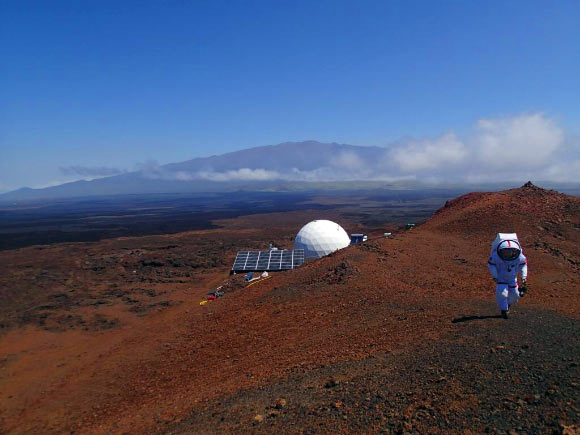Six astronaut-like members of NASA’s Hawaii Space Exploration Analog and Simulation (HI-SEAS) team have embarked on the longest dedicated space travel simulation ever conducted in the United States.

HI-SEAS team members will stay in a dome on the Mauna Loa volcano in Hawaii. Image credit: Sian Proctor / University of Hawaii at Manoa.
On October 15, 2014, HI-SEAS members closed the door to their faux Mars habitat and shut out the rest of life on Earth.
In so doing, they stepped into uncharted territory – beginning an 8-month investigation into social, interpersonal and cognitive factors that affect team performance during long-duration space travel, such as missions to Mars.
“We need to know more about how the mind works, how individuals contribute to a team, and how that team dynamic changes over time in order to anticipate how astronauts will react during long-duration space travel,” said Dr Kim Binsted of the University of Hawai‘i at Mānoa, principal investigator for the program.
The HI-SEAS team will live in a habitat located at an elevation of about 2,500 meters in an abandoned quarry on the northern slope of the Mauna Loa volcano on the Big Island of Hawaii.
The basaltic terrain and sparse vegetation of the site make it a good geologic analog to the Moon or Mars, and since the site is accessible year-round, it allows for longer-term isolation studies than other analog locations.
The site contains no rare, threatened or endangered species, and no archaeological sites or cultural practices.
“It’s analogous to Mars but translates well to any situation that requires teamwork and a reliance on technology,” said team member Jocelyn Dunn, a doctoral student at Purdue University.
The habitat is based on a dome supplied by Pacific Domes International with internal two-story structure. The first floor has a kitchen, dining area, common work space, exercise area, and lab. The second floor contains six crew-sleeping quarters and a bathroom.
Although numerous space analog studies have been conducted over the years, this is the longest U.S. study to-date. Worldwide, only the Mars500 study during 2010-2011 surpasses this one in total duration.
Simulated space walks will provide HI-SEAS members with a chance to experience the outdoors, but only while wearing bulky simulated space suits.
Email communications with the outside world will be subject to a 40-minute delay to simulate how long it takes for a message to get from Earth to Mars and vice versa.
As the team members go about their daily activities inside the HI-SEAS habitat, scientists from the University of Hawai‘i at Mānoa will be studying the team’s cohesion over time, gathering data on a wide range of cognitive, social and emotional factors that may impact performance.
The team members will be continuously monitored using biometric trackers, electronic surveys, and other surveillance methods.







